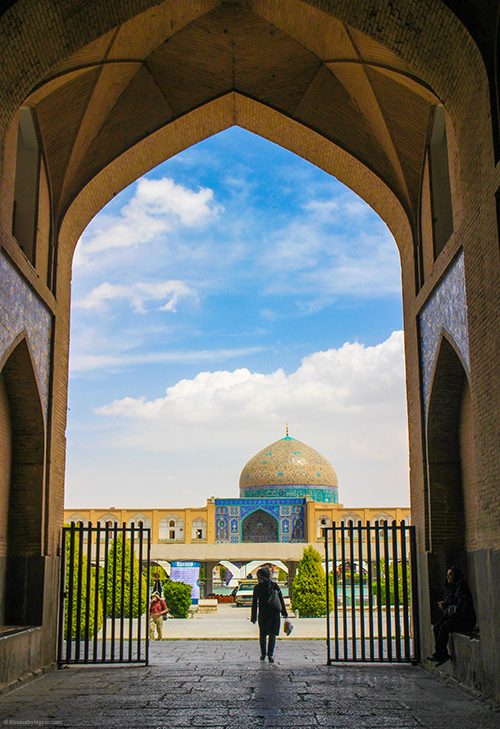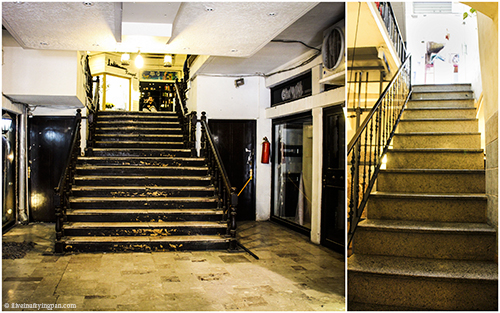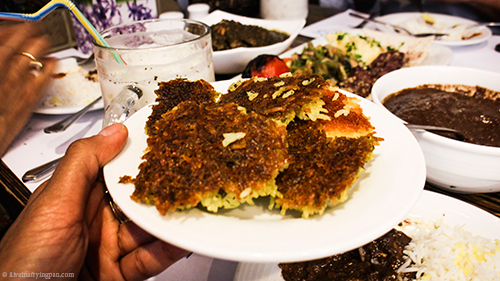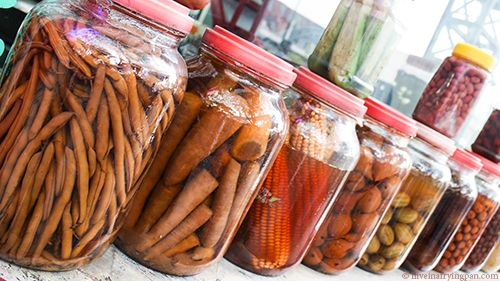The more I have tasted the melting meats, fragrant pilafs, slow-simmered stews and sweet-savoury expanse of flavours expertly navigated by authentic Iranian restaurants in Dubai, the more I have longed to visit. I finally embarked on my first small journey to Iran last week (thanks to Jason Rezaian, Tehran correspondent for the US-based Washington Post). One would hope that this 8-day trip would have quenched my burning thirst to learn more about the cuisine – but far from it. My visit has only fired up new questions, new desires and an even greater hunger to learn, one that will take many more trips to sate.
It must be known that a cuisine as ancient, rich and nuanced as Iranian food is one that varies as profoundly as the climate and terrain of the country – you can wrap up warmly near the Alborz mountains, wipe your sweaty forehead near arid desert ground and have an Arabian Nights moment in shaded lush gardens, all in one week. And I did. The best way to eat through the intricacies borne of such diversity is not in restaurants, but in the homes.
Parking yourself in someone’s home is not as easy of an endeavour unless you peel yourself away from the inspiring and maddening array of monuments, pitch yourself in a city for a decent enough amount of time and interact with the unbelievably hospitable people. When we finally slowed down to connect with a couple who was just gushing to take us home in Shiraz, it was time to fly back to Dubai. This is one of the many reasons why I must return to Iran.

Looking out of the bazaar at Nagshe Jahan square, Isfahan. One of the architectural highlights of my trip.
Nevertheless, despite being limited to the restaurants in Tehran, Isfahan and Shiraz and not covering even 1% of the flavours to be experienced, I am grateful for the mouth-watering food insights that came my way. And even though I have tasted and researched a fair amount about Iranian cuisine in the past, there were still surprises to be had. Here are the top ten food surprises – a disorderly mix of foods, observations, reflections – that I digested across three of the most well-known cities of Iran:

Dried mint + drinking yogurt made out of sheep’s milk = Magic (aka Doogh)
It took one sip of the Doogh at our first restaurant stop in Tehran to leave us completely addicted to this milky concoction swirled with dried mint leaves. Served either homemade or from store-bought bottles, the drink leaves a cool minty breeze in the lower reaches of your chest and is the perfect balance to a kabab orgy that most restaurant runs in Iran tends to become. But the big revelation was that doogh made out of goat/sheep's milk yoghurt is infinitely more appealing than cow’s milk, making your mouth pucker up at the edges with the sour, sharp tang of the drink before you reach out for your next juicy slab of kabab. It is less common through, the only place we swished down homemade goat's milk doogh (pictured above) was in the Tehran bazaar, at an impossible-to-find restaurant called Maha. Even if you don’t find a homemade goat’s milk version, I’ll be honest – the store-bought cow’s milk doogh with imposter mint essence was pretty darn good too.

Sheep fat.
Since we’re on the goat and sheep theme, the use of sheep fat was one of the surprises that wafted up out of a plate of one of my favourite Iranian pilafs, baghali polo ba maahicheh (pictured above). The strong smell instantly hit me as I brought a spoonful of the rice with dill and broad beans closer to my face. It wasn’t the massive lamb shank on the plate that was gamey in the least – in fact, none of the meats we had in Iran had any strong aftertastes. The nose-curling smell was entirely in the fat used to cook the rice, and many spoonfuls later, it might grow on you as it did for me. While not for everyone, rice cooked in sheep fat is worth a try at least once.
The same restaurant in Tehran called Arvand Kenar served us the most plump and explosively juicy lamb chops (shishlik) I have ever had the privilege of chewing off the bone. No surprises there, given how adept Iranians are with grilling their meats.

[Arvand Kenar Restaurant location: Valiasr Street, below Park Sayee across from the Hotel Simorgh]
Missing cyber food talk.
At first, this might come as a surprise to those who know how seriously Iranians take their food. Even our in-flight meal was shockingly good – I polished off the tub of fluffy rice and chicken eggplant stew within minutes. But when you go online, other than one restaurant guide and blogs written by Iranians abroad, there is a big gaping hole for insider restaurant guidance or local food blogs up on the web – or at least those written in English. If you want to find the best zerehk polo ba murg (rice with barberries and chicken, pictured below), no one would have psychoanalyzed the subject in the way that croissants have been hunted down in France or shawarmas and Friday brunches have been pinned to online slide shows in Dubai.

I doubt that the cyber restrictions in the country have anything to do with it – everyone has VPN and bypasses the firewalls. Jason suggested that it might be because people in the country are so accustomed to a high standard of flavours that it’s just not something people tend to feel the need to write about. It’s a given, like bathing everyday – except the flavours of an authentic Iranian meal is akin to bathing in a gold and azure-tiled hammam with milk, honey and copious amounts of saffron.
The Lonely Planet, often an excellent referral source of hidden food gems, also fell short in Iran. Other than one decent restaurant recommendation, the edition felt outdated or incomplete in parts, and two of the places we visited were overrun with tourists like ourselves clutching on to their Lonely Planet guidebooks. You’re better off just wandering out on your own.

Eerie staircases leading to hidden restaurants. The norm.
If it wasn’t hard enough to find restaurant recommendations, the fact that many restaurants are tucked away underground or in some non-descript part of a building takes the challenge of finding them to a whole other level. It’s almost as if the restaurant doesn’t want you to discover it. One of the best places we visited with a carpet seller (thank you Hossein!) in Tehran had the following signboard:
 You get my point. Other than a simple Persian lettering on the glass door that we found after our meal, there was nothing to help us ever find Maha again.
You get my point. Other than a simple Persian lettering on the glass door that we found after our meal, there was nothing to help us ever find Maha again.

Fresh-baked bread snug under elbows, on outstretched arms, on anywhere but in a plastic baggie.
This might be typical in other countries of the Middle East, but it just doesn’t happen in Dubai. You never see someone step out on the streets here with an exposed disc of bread clasped between their elbow and their side, or like a serving tray on their palms with a tub of butter/cheese poised on top. If only I had been quick enough to snap a photo of someone doing this! But this was typical in Tehran, especially in the morning when people seem to have a simple breakfast of bread, preserves (quince, carrot, sour cherry, we even saw aloe vera), cream, salty feta cheese and/or walnuts. The variety of breads was incredible, though not surprising at all and I’m glad to say I have enough bread tastings in me to warrant a separate post. But before I move to the next point...
 ...another hearty memory of a bread that kept me going on our road trip from Tehran to Isfahan.
...another hearty memory of a bread that kept me going on our road trip from Tehran to Isfahan.

The glorious Iranian rice crown. Worlds apart from the burnt blackish crust you find at the base of a rice pot forgotten on your stovetop.
While some Iranian restaurants in Dubai serve food that is actually quite comparable to the above-average joints in Iran – I have yet to eat a tahdeeghere that rocks my world. After my first tasting of the rice crust (poorly pictured above, but don't be fooled by my rubbish photography), I was hooked and made it a point to order it again at every restaurant. Tahdeeg is intentionally formed on the bottom (taht) of the pot (deeg) after the rice has been steamed. This is the last step in a complex series of washing, soaking, parboiling and steaming the grains in the chelow rice technique. The best tahdeeg were those with a crisp, buttery, golden brown or deep caramel brown crust on the top, soft squishy grains fused together at the base, and heady with the aroma of saffron. In some cases, the restaurants would add yoghurt to the rice and saffron mixture at the base of the pot, making the ‘rice crown’ experience even more tender and sublime.

Koresht Mast in Isfahan.
This dish deserves to be singled out on its own pedestal – you’d have to be if you were made out of sugar, saffron, yoghurt, eggs, heaps more sugar and saffron, and…shredded cow or sheep neck.
The collagen from the neck meat makes this eccentric local stew one that is strikingly similar to a rich gelatinous porridge (a comparison I must draw because of course, we all eat gelatinous porridges every day). Our local friends in Tehran didn’t vouch for this Isfahani speciality, but against all odds, mum and I actually enjoyed the Koresht Mast at Khan Gostar. At some points, it resembled a Gujarati hung yoghurt dessert called shrikhand that we love scooping up with deep fried bread at home. And at other points, it brought on memories of a savoury meat and wheat Indian porridge called Haleem that we also love.
Love + Love = More Love.
[Khan Gostar Restaurant Location: Jolfa Hotel, Hakim Nezami Street, opposite Vank Church on the Armenian-Christian side of Isfahan.]

Staggering variety of pickles.
And being an Indian, I thought I knew my pickles. Shops in the Tajrish market as well as across other bazaars we visited in Iran were piled high with a dizzying range oftorshi, pickled vegetables and fruits. I was aware that Iranians have an affiliation to sour tastes, but I could never have imagined the variety of pickles on offer – some of which didn’t even resemble ingredients we have seen before. Pickled beans, pickled carrots, pickled corn on the cob, pickled bananas…and naturally, pickled kiwis.

Food self-sufficiency.
As it should be, given the global sanctions. But I still didn’t think of Iran as a rich agricultural community and was surprised to learn from Jason – who is particularly passionate about starting a new trend of growing avocadoes locally (“less than 1% of Iran’s population has ever tasted an avocado.”) – that “Iran is one of the most fertile countries on earth, and its land produces great bounty.”

His words rang true as we sauntered through the Tajrish market, bagging up burstingly ripe strawberries for our ride home, watching ladies having their stewing herbs chopped up in bulk, and puzzling over ingredients that stumped even my very own ingredient-savvy Wikipedia – mum. After a dedicated Facebook inquiry, two Iranians confirmed that this plant is called...

...Valak. What?!
White liver. Chopped and fried.
I’ve spoken about the riceless Isfahani biryani in Dubai before, but now I could finally taste it in its birthplace. We passed by two biryani shops on our walk through the Nasghe-Jahan bazaar in Isfahan, and thankfully both were conspicuously signposted and were advertising their one and only dish, biryani (but you still have to walk to an underground dining room to eat it.)

A soft pasty patty of fatty lamb mince arrived on a stone-baked sangak bread that had been splashed with a slow-simmered oily broth of bones. Unlike my experience in Dubai, there was no lamby aftertaste despite the concerningly strong smell in the air. The portion seems deceptively small, but I'd recommend splitting one order of biryani between two people. If you alternate the tender mince swaddled in bread with swigs of bottled doogh, the meal won’t be as rib-stickingly heavy as claimed by the popular warnings about this dish.

But the surprise lay not in the patty, but rather in the powdery crumble on the side. It bore the telling brown shade of caramelization, with a taste that felt different from the patty in a way we couldn’t quite describe. At the time, it seemed as if the same meat had just been flash-fried on high heat rather than being cooked as a patty.
It was only after returning to Dubai that my Iranian spice shop mentor, Mr. Reza, pointed to his chest and described the crumble as ‘white liver’ (‘black liver’ being the digestive organ as we know it in the rest of the world.) In Persian speak, white liver is lungs. Now that that puzzle is solved, I can finally breathe better.
But the biggest shock was a personal one.
Halfway through a weeklong trip with multiple flawlessly-grilled kabab and koresht(stew) meals to our credit, we simply could not eat meat anymore. It was too much even for me, the girl who blended kababs into a puree when her wisdom teeth were yanked out and she was forced on to a liquid diet. I simply could not consume another kabab. You will be disappointed to hear that there were a few instances when we cowardly took meatless refuge in:
…styrofoam cups of corn mixed with processed cheese, butter and mushrooms (to make things only marginally more respectable, let me assure you that we didn’t let the street stall add mayo to the mix.)

…chewy bastani, or ice cream, slapped between two wafers. A must-do.

…and for our last meal, we did the unthinkable and caved into pizza, no chano(beef) please. Our super hospitable guide seemed offended that we’d ordered the lesser of the pizza mortals and offered us a slice of his minced beef pizza. This was not the first time that someone had literally put their food into our plate before eating it first themselves. But no surprises there, Iranian hospitality is a well-known fact.
Hats off to a culture that not only nurtures brilliantly rich and complex flavours, but also encourages the warmth and generosity to share them around.

By I Live In A Frying Pan
The Iran Project is not responsible for the content of quoted articles.

 QR code
QR code